Episode 154 Show Notes
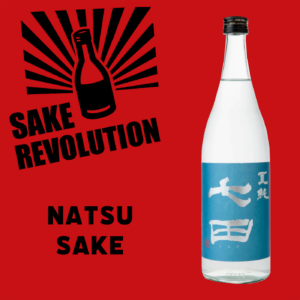 Episode 154. Taking a quick detour from our American Craft Sake Festival series, we’re sneaking in a seasonally appropriate episode before it’s too late. “Natsu Sake” or summer sake, is a new-ish genre of brews meant to take the edge off of the sweltering summer heat, all while letting us enjoy the flavors of sake in the summer. Often presented in clear or frosted bottles with cool-toned blue-ish labels, these sakes definitely give off a chill vibe. With lower alcohol as well as clean, crisp and refreshing flavors, these sakes shine when served icy cold. As the dog days of summer are a traditionally slow time for sake sales, these cool Natsu Sakes are meant to inspire us to drink a chilled nihonshu instead of a cold brewski or that wine spritzer over ice. More and more summer sakes are hitting shelves here in the States, just as temperatures are hitting record highs. Let’s take advantage and chill out with some wonderful natsu sakes.
Episode 154. Taking a quick detour from our American Craft Sake Festival series, we’re sneaking in a seasonally appropriate episode before it’s too late. “Natsu Sake” or summer sake, is a new-ish genre of brews meant to take the edge off of the sweltering summer heat, all while letting us enjoy the flavors of sake in the summer. Often presented in clear or frosted bottles with cool-toned blue-ish labels, these sakes definitely give off a chill vibe. With lower alcohol as well as clean, crisp and refreshing flavors, these sakes shine when served icy cold. As the dog days of summer are a traditionally slow time for sake sales, these cool Natsu Sakes are meant to inspire us to drink a chilled nihonshu instead of a cold brewski or that wine spritzer over ice. More and more summer sakes are hitting shelves here in the States, just as temperatures are hitting record highs. Let’s take advantage and chill out with some wonderful natsu sakes.#SakeRevolution
Skip to: 00:19 Hosts Welcome and Introduction
Welcome to the show from John and Timothy
Skip to: 03:56 “Natsu” or Summer Sakes
What is “Natsu Sake” or “Summer Sake”?
While there is no legal definition of Summer Sake in the Japanese sake industry, it is most often defined as a seasonal sake release targeted for distribution and consumption in the summer months. Usually these sakes are lighter and cleaner and take well to chilling to help combat the heat. Often they are also lower alcohol and sometimes sparkling as well. Packaging conveys a crisp, cool impression, often using clear bottles or frosted bottles. Labels care often and icy-blue tone.
Some examples of Natsu Sake:
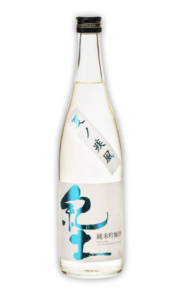
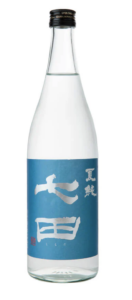
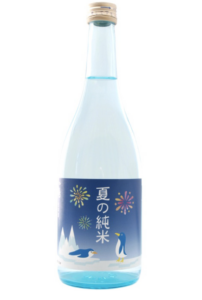
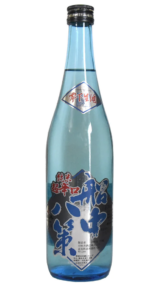
Skip to: 11:52 Sake Introduction and Tasting: Shichida “Natsu-Jun” Junmai Namazume
Shichida “Natsu-Jun” Junmai Namazume
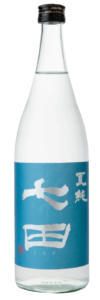
Classification: Junmai, Namazume
Brewery: Tenzan Shuzo
Prefecture: Saga
Seimaibuai: 60%
Rice Type: Dewasansan
SMV: +2.0
Alcohol: 14.0%
Acidity: 1.3
Brand: Shichida (七田)
Importer/Distributor: JFC (USA)
NOTE: Use Discount Code “REVOLUTION” for 10% off your first order with Tippsy Sake.
Skip to: 25:36 Show Closing
This is it! Join us next time for another episode of Sake Revolution!
Support us on Patreon
 Now there is a new way to support Sake Revolution. Join us on Patreon! Patreon is an online platform that allows you to support your favorite creators by subscribing to a monthly membership. At Sake Revolution, we’re offering two tiers, each with its own perk. If you enjoy our sake podcast, if you are able, please consider supporting this labor of sake love! See below to learn about our Patreon support levels.
Now there is a new way to support Sake Revolution. Join us on Patreon! Patreon is an online platform that allows you to support your favorite creators by subscribing to a monthly membership. At Sake Revolution, we’re offering two tiers, each with its own perk. If you enjoy our sake podcast, if you are able, please consider supporting this labor of sake love! See below to learn about our Patreon support levels.
-
Sake Enthusiast
Have you ever wanted to sip along with us as we taste our sakes on the podcast? Now you can! As a Sake Enthusiast patron, you’ll get the inside track and know in advance which sakes we’ll be featuring on the show. This allows you to get them on hand and sip along with us while you listen.
-
Sake Otaku
As a Sake Otaku supporter of the pod, you’ll get access to all the Sake Enthusiast intel along with access to a monthly live zoom Sake Happy Hour taking place the first Weds of every month at 9pm ET (6pm PT). Visit with us live on zoom! Come with all your questions and suggestions and enjoy a relaxed and fun Happy Hour with with us as we all sip sake together!
Episode 154 Transcript
John Puma: 0:21
Hello everybody and welcome to Sake Revolution. This is America’s First Sake podcast and I’m one of your hosts. My name is John Puma. You may know me from the Sake Notes. You may also know me as the guy who runs the Internet Sake Discord. and if you pop over to Reddit’s R slash sake community, you’ll also see me there. I.
Timothy Sullivan: 0:40
and I am your other host, Timothy Sullivan. I’m a Sake Samurai. I’m a sake educator, as well as the founder of the Urban Sake website. And every week John and I will be here tasting and chatting about all things sake and doing our best to make it fun and easy to understand.
John Puma: 0:56
I have to first apologize to our listeners. We made a promise last week that our next few episodes would have been taped live at the American Craft Sake Festival. And here we are the third week after that and we have already moved on to something else. Now. Now don’t fret. This is not us moving on. This is just, just having, uh, a topic that was very timely. if we waited till we were done with all the craft sake episodes, it might’ve been too late.
Timothy Sullivan: 1:27
well, there’s late breaking news on the resolution front. I actually just returned from a brief but impactful trip to Japan, so I fulfilled my revolution resolution for this year. but I made a vow years ago, never to return to Japan in August, and I broke that vow for this business trip. Had to do it, and it was, it was, the time I spent with friends and coworkers was fabulous, but it was summer, it was August in Tokyo.
John Puma: 2:03
Mm-hmm.
Timothy Sullivan: 2:05
You know what that means?
John Puma: 2:06
Yeah, it’s hot. I have been told I’ve never been to Japan in the summertime, and that is because anyone I’ve ever met who has been to Japan in the summertime has told me, whatever you do, do not go to Japan in the summertime. And I follow instructions remarkably well when it comes to hot weather.
Timothy Sullivan: 2:25
Well, it was the, the word that comes to mind is swampy. Swampy. Like, you step outside and it’s like you’re stepping into, humidity soup. That’s kind of what it feels like. Yeah.
John Puma: 2:39
it sounds like Florida in, in like July.
Timothy Sullivan: 2:43
It’s, it’s really humid, really hot. And the Japanese word for humid is my favorite. Humid weather is Mushi Atsui. Like mushy hotness?
John Puma: 2:54
I got
Timothy Sullivan: 2:55
no. Mushi Atsui.
John Puma: 2:59
I like that one a lot. That was really good. Um,
Timothy Sullivan: 3:03
not sure that’s the real translation, but that’s what it sounds like. Now,
John Puma: 3:09
and now you’re back.
Timothy Sullivan: 3:10
I’m
John Puma: 3:10
You’re back. You, you’ve accomplished your, you’re goal for this year and now you’re not gonna go back to Japan at all for the rest of the year, right?
Timothy Sullivan: 3:17
I wouldn’t say that there might be, maybe, maybe there’s another trip in me yet, but, uh, I thought that while it’s still summer here, we should talk about kind of a new category of sake that’s emerged in Japan
John Puma: 3:33
Yeah, my Understanding is that this, this, this type of sake we’re gonna be talking about today has only been around for, well, since around 2007 or so. That’s recent.
Timothy Sullivan: 3:44
It’s really recent. I don’t know the style much from before then, so, uh, what are we talking about today?
John Puma: 3:51
Well, uh, in honor of your hot and sweaty
Timothy Sullivan: 3:54
Sweating to the oldies.
John Puma: 3:56
visit to Tokyo, in honor of your hot and sweaty visit to Tokyo, we’re gonna talk about summer sake. The Natsu Sake”NATSU” is of course, summer in Japanese. It was very straightforward. Not a lot of mystery there.
Timothy Sullivan: 4:10
As you just said. Natsu means summer in Japanese, so Natsu sake is just summer sake.
John Puma: 4:19
Yeah. Summer sake. I, it’s nice and easy rolls off the tongue if you’re careful. And so what, what, what, like, do, like, there’s a lot of structure we have found in sake. A lot of things with specific names and specific names have specific meanings. So natsu sake, summer sake, what, what is, what defines summer sake?
Timothy Sullivan: 4:42
Well this is kind of a new marketing term. It is not legally defined by Japan. So it is just something that brewers label their sake when it’s released for consumption in summer and usually shipped to arrive to consumers in summer. So there’s no other definition other than it’s available in summertime, or it’s a seasonal release for breweries.
John Puma: 5:08
Alright. So does it have any like, common characteristics to it? Like obviously nothing that is being, uh, thrust upon them because there’s no hard and fast rules about it, but like, what are they going for? What’s the, here’s a good one. What’s the vibe of summer sake?
Timothy Sullivan: 5:26
Well, if you go into a liquor store in Japan in the summer, there’s probably gonna be a shelf of summer sake for these sake specialty liquor stores. And they all have common characteristics. Now, you and I have talked about fall release sake, right? Hiyaoroshi. Yeah. And that has a very common packaging to it. There’s always like autumn leaves tumbling on the label and things like that. And it’s
John Puma: 5:55
uh, a lot of red, a lot of brown.
Timothy Sullivan: 5:57
Yes, very much those autumnal vibes, and it’s similar for Natsu or summer sake. Very often the bottles are clear and or frosted white, and the labels often have some kind of sky blue component to the label, and they just give off this really cool, refreshing vibe to them. So that’s the whole notion behind this summer seasonal sake. You’ve seen a few on the shelves here in New York, right?
John Puma: 6:28
Oh, yeah. Um, I wanna say that we started getting, uh, Natsu sake here in New York only a few years ago. It’s a, it’s a recent phenomenon. I., in my mind it’s like, 20 18, 20 19 it feels like.
Timothy Sullivan: 6:43
Yeah,
John Puma: 6:44
Yeah.
Timothy Sullivan: 6:45
but I, I do have to say that it feels like there’s more now than there ever have been in the past. Like it feels like a real trend that’s picked up and many breweries have started to release a summer sake.
John Puma: 6:59
Yeah. I like the idea and I have had quite a few of them. if you go to Japan in, in late May, you, you can sometimes see them on the shelf at the, like, like, so when I, I’ve got, I’ve gone to Japan in, in late May a few times, or, you know, dipping into early June a little bit, and they start to show up on like the tail end, the last couple of days, the trip, you start to see them on the shelves and yeah, it definitely comes across as something that’s a little bit like refreshing. It’s supposed to be something you’re having nice and cold, like I, I, I really like that. Is there anything else about them that I should know if I’m gonna be sipping on summer sake?
Timothy Sullivan: 7:35
Well, one other thing that I was thinking about this is that, you know, for winter it’s very common to drink warm sake and sake has a real home in the wintertime, but in the summertime it’s most people’s go-to beverage is gonna be like an ice cold beer or something. A little bit more refreshing. So I think this is also a marketing opportunity and I think to combat sagging sales in the summer. Brewers more recently came up with this concept of summer seasonal releases to boost sales. So it, I can’t deny that there’s a little bit of a marketing angle in there too.
John Puma: 8:12
I, I’m sure there is. So what should we expect from the taste though? I, I mentioned that things are going for refreshing, but like, what, what’s really going on there?
Timothy Sullivan: 8:20
Yeah. I think there’s a few characteristics when you actually get to drinking the sake that are important. One, they’re a hundred percent always meant to be consumed cold, so you want something well chilled, refreshing, and that usually translates to cleaner. Drier and usually something that has that refreshing, crisp finish to it. So this is starting to go right up my alley.
John Puma: 8:45
I was about to say, this is, it just sounds like a dream season for you with the possible exception of having to be in Japan the summertime.
Timothy Sullivan: 8:52
and, uh, another thing that you often see in the summer sakes is low alcohol. Because you don’t want to be sweating to the oldies in the summer and just downing too much alcohol. You’re gonna keel right over. So a touch lower alcohol, sometimes sparkling ice cold sparkling is also seen for summer sake, but just think crisp, refreshing, light, and delicious.
John Puma: 9:17
Nice. so how much lower are we talking here? Are we talking like 6% or are we talking more like 14%?
Timothy Sullivan: 9:23
It can range from eight, eight to 10% up to 14, 15%, but usually they, they veer below 15 just to get just the edge of lightness to them.
John Puma: 9:35
this year I had, on a few occasions I had the, KID, uh, summer sake that the, uh, Heiwa Shuzo KID, uh, natsu sake, which is, is very light, very refreshing. It has a nice little bit of fruit to it too. Dry, crisp, finish. Mm. Really tasty stuff. I really liked it a lot. didn’t see as many this year as I think I might have seen in past years, but still am nice to see them on the shelves.
Timothy Sullivan: 10:00
Yeah, like we just said, there’s been a number coming
John Puma: 10:03
Mm-hmm.
Timothy Sullivan: 10:04
coming to the States, so there’s a wide variety to choose from, and I think that as long as I’m in the AC I can, really enjoy those crisp, light summer style sake is even more.
John Puma: 10:21
Hmm. I like it. I like it. As you pointed out though, this is definitely not something you’re gonna warm up or play with the temperature on. You’re gonna, you’re gonna enjoy these cold for those hot days.
Timothy Sullivan: 10:33
Yeah, I think. They’re gonna avoid kind of all extremes. It’s not gonna be high alcohol, it’s not gonna be super fruity. It’s not gonna be really rich in coating. I think they’re aiming for lighter, cleaner crisper, and it’s just gonna be that super easy drinking type, uh, that you can over chill without any worries. You know, when we teach the sake Somm classes, we warn the students not to over chill sake because it can really dampen the aromas and the flavors. But I think the Natsu summer sakes are very easy to drink because you can chill them quite a lot and they’re gonna be just as enjoyable. So there’s not much worry about over chilling them.’cause they’re really meant to be served in that bracing cold temperature.
John Puma: 11:18
Nice. So it sounds to me like they looked at the situation, they’re like, huh, people really aren’t drinking a lot of sake in the summertime. Let’s make something that I. It has a little bit less alcohol, so it doesn’t completely ruin your day if you’re having it outside when it’s nice and hot out and go and leans into the cold, refreshing side of sake. And can, can maybe, maybe be something that somebody would pick up instead of a beer.
Timothy Sullivan: 11:47
I hope they do.
John Puma: 11:48
Yeah. Or, or maybe instead of a white wine in the US
Timothy Sullivan: 11:52
Yes. Now we’ve selected one of these summer sakes to enjoy together today, John, and I’m kind of ready. All this gibber jabber. I am ready to try it. So what, what sake have we selected to represent our, our summer seasonal this year?
John Puma: 12:10
So I’m very excited because I have not yet had this year’s version of it. This is the, uh, Shichida Natsu-Jun. It’s Natsu Junmai. They love to abbreviate things. and it’s a Nama-Zume, so it is once pasteurized. Um, Shichida of course is, uh, from, uh, Tenzan Shuzo over in Saga. We’ve had quite a few visits to Saga on our show before, and, um, even though they’re in Saga, the rice on this one is Dewasansan.
Timothy Sullivan: 12:40
Oh, should i?
John Puma: 12:41
It’s got its own song.
Timothy Sullivan: 12:43
Should I start singing?
John Puma: 12:44
No, no, I think we’re good. Uh, we got dewasansan milled down to 60% and, uh, sake meter values plus two, that, that dryness of sweetness is just a touch on the dry side. acidity is 1.3, this is so pleasant sounding. and then the yeast is, saga F 4 0 1 and Association 1801.
Timothy Sullivan: 13:09
Alright, so we’ve got it in the glass. Let’s give it a smell.
John Puma: 13:13
Yes. Hmm. I wanna say is a touch more aroma on this than I was expecting?
Timothy Sullivan: 13:21
Hmm. But it’s very fresh smelling, isn’t it? Like it makes me think of cucumber. Maybe some pear, bright and fresh. Smells absolutely delicious.
John Puma: 13:31
Yeah. And there’s, there is a, there’s a faintness to, there’s, there’s the fruit, there’s, there’s some, if you’re looking for, there’s some, some tropical fruit on there. But it’s very, very faint. The, the refreshing aspects of it are much more important and much more prominent.
Timothy Sullivan: 13:48
Hmm. Very nice. Alright, let’s give it a taste. Hmm. That’s outstanding. That’s really good.
John Puma: 13:56
Oh. It’s, it was, uh, nice and hot out today, Tim. I really wish we would’ve had this outside. We could have set everything up in, uh, on a table on the street that would’ve not caused any problems at all.
Timothy Sullivan: 14:05
Yes, this is refreshing Bright.
John Puma: 14:09
Hmm.
Timothy Sullivan: 14:10
It has a super gentle, fruity component to it, but the thing is, it’s easy drinking. It’s not gonna tax any of your systems. It’s not overwhelming with aroma. It’s not too rich on the palate, but it’s still really clean and having it nice. I have it very well chilled right out of my sake fridge, and it’s absolutely delicious.
John Puma: 14:31
Uh, so the people at home know what, what is your sake fridge currently set to?
Timothy Sullivan: 14:36
It’s set to about 47 degrees,
John Puma: 14:39
Okay. So nice and chilled.
Timothy Sullivan: 14:40
so it’s warmer than a traditional fridge would be, it’s actually a modified beer fridge, so that’s
John Puma: 14:47
Hmm.
Timothy Sullivan: 14:47
temperature is.
John Puma: 14:48
Yeah, those beer fridges get very cold.
Timothy Sullivan: 14:49
Yeah.
John Puma: 14:50
So, yeah, this is, um, really nice and, and this is, this falls into that, uh, that category that I often you get in trouble with is like, you know, I can accidentally, oops, the bottle’s gone because it is so, Light and as, and as you pointed out, I like the phrase not taxing. That’s really nice. It’s, it is, it’s easy. You can easily put a drink this, you’re easily gonna refill it. You’re easily gonna have some more.
Timothy Sullivan: 15:17
Yeah. I feel there’s a,
John Puma: 15:19
on a hot day.
Timothy Sullivan: 15:20
hmm. Especially on a hot day. Yeah. I feel like there’s a, a peachy note on the palate that didn’t come through on the aroma for me, like kind of a summery, peachy Had a little crisp cucumber on the palate as well.
John Puma: 15:37
Mm. The cucumber, I a hundred percent get peach is a little fainter. It’s hard, harder for me to pick up. Truth be told, I just had dinner before we recorded, and my dinner was Thai. So my taste buds are a little tired right now. But this is really good.
Timothy Sullivan: 15:54
Really, really good.
John Puma: 15:55
Yeah. Yeah. And I, I wanna say that this is one of the first that I remember seeing in New York. I think it was probably in like 2018 or so. And I remember like seeing it they use a, a frosted white bottle with the, with the baby blue label. And, and we’ve talked a about the, Shichida label scheme and label design of how it’s like, more or less the same with the big, easy to recognize, uh, very stylistic kanji on the front and then a different color label for each one of the sakes. And it makes it really easy for people to pick it up and go, oh, hey, I’ve had this one. I liked the red one from these guys. Let me try this other one. Lemme try this green one. Or in this case, this blue one. And it’s just, it’s just really nice. And there’s a, consistency of quality, I think, across so much of the stuff that Shichida puts out.
Timothy Sullivan: 16:51
I think we talked about that on our label episode, right, where we talked about sake labels. Yeah. And I have the bottle here and if anyone listening wants to see the picture of this Natsu June from Shichida, just visit SakeRevolution.com and the show notes will show you a picture of the bottle. And as John said, it’s clear frosted with a blue label, and it has the very simple to read Shichida kanji on it with a silver foil. says Shichida underneath that in, English letters. So it’s really simple but easy to recognize packaging. And it follows all the rules for Natsu branding.
John Puma: 17:33
Absolutely. Uh, I forgot about the silver foil. That is another like, nice little touch.’cause it pops like it’s, that’s really nice. It stands out on the shelf, I think.
Timothy Sullivan: 17:42
yes. And silver is more like a, uh, cool color. If it was gold, it would be more warming feeling, but the silver is a little, just feels more cold. Cool. To the touch. I don’t know. It’s very, very well done.
John Puma: 18:00
Yes.
Timothy Sullivan: 18:00
packaging.
John Puma: 18:02
Yeah. And then, and then you pour it into the glass and it, and it lives up to that light and refreshing. Uh, yummy.
Timothy Sullivan: 18:09
This is a sake, this is a sake where I would break one of my rules.
John Puma: 18:14
alright? Wait a minute. Wait. Timeout. What are your rules?
Timothy Sullivan: 18:17
I have a rule
John Puma: 18:19
Alright, which, which rules specifically are you breaking for this sake?
Timothy Sullivan: 18:23
When I put sake on ice in an ice bucket, my rule is don’t use water, just put it on solid ice cubes. But I would actually stick this bottle in ice water, and that really chills it down. You can bring the temperature of a sake down dramatically if you put it in ice water. When I train servers in restaurants, I always warn them, don’t let too much water accumulate in your ice bucket, or you’re gonna over chill your sake, and that can dampen aromas and cause sometimes bitterness on the finish, if you over chill sake, the wrong kind of sake over chilled is not gonna be as enjoyable. But this puppy right here, this one. I would, especially on a hot day if I was on the veranda or eating outside or you know, not under my AC as I am now, I would put this in ice water and really bring that temperature down and really chill it, and I think it would make it even more crisp on the finish and bring out that wonderful cucumber brightness and just, you know, overall clean flavors would really come out with that extra chilling.
John Puma: 19:38
Nice. Nice. So if I have a party in the summertime, I should, uh, and I, I, Tim Sullivan, I’m gonna expect you to bring some ice cold summer sake.
Timothy Sullivan: 19:49
Yes, I’ll come with my ice bucket. I’ll come with my homemade clear ice cubes
John Puma: 19:55
I was about to ask if you would, if you would use your, your homemade ice for this, or if it’s like not the right use of the special Tim Sullivan ice
Timothy Sullivan: 20:04
I usually don’t use my homemade ice to chill bottles, but I can. I can make an exception for your party
John Puma: 20:11
in this case. And this is just this one
Timothy Sullivan: 20:12
In this very special case. John, all you need to supply is the water.
John Puma: 20:17
I’m on it. I’m, I got it. I can, I can supply some water and uh, and of course I could bring some wine glasses and we can enjoy all this.
Timothy Sullivan: 20:25
is this
John Puma: 20:26
a
Timothy Sullivan: 20:26
sake you are going to just drink on its own, out on the patio, on the lanai, or are you gonna pair this with any food?
John Puma: 20:33
there’s, there’s never been a time I’ve more wanted a terrace than right now. Uh,’cause it’s, I feel like I’m pairing it with the heat, right?
Timothy Sullivan: 20:45
it. I love it. Yes. This is paired with sweltering temperatures.
John Puma: 20:50
Well, maybe not sweltering. I forgot you just got back from Japan, so it’s a little bit more for you.
Timothy Sullivan: 20:55
Yes. Pair this with Mushi Atsui.
John Puma: 21:00
Uh, so actually, so having just been over there,
Timothy Sullivan: 21:03
Yeah.
John Puma: 21:04
Would you even have this outside or would you just be like, oh no, I need right back inside.
Timothy Sullivan: 21:09
I would not eat outside in that heat for a case of this sake. No, I’m kidding. Yeah, it’s, it’s very unpleasant. And most, you know, outside dining is kind of out of the question. Uh, one of the hotels I stayed in had a patio for, they had like a free breakfast and they had a patio outside and it was like empty. Everyone was crammed inside under the air conditioning. It’s just, just, you know, one more month and then cool temperatures are gonna return to Japan. But in July, August, it’s really
John Puma: 21:43
It’s, uh, it’s
Timothy Sullivan: 21:45
It’s mushy.
John Puma: 21:47
mui. So I, I don’t know if you, if you caught any of these while you were there, but oftentimes there’s a lot of places, a lot of like, uh, uh, a lot of. Sometimes like a tachinomi or standing bars that are kind of open to the outside, but with just like a curtain, like a plastic curtain. Um, what were the, were they o, were they getting customers? Like what were they doing in this heat?
Timothy Sullivan: 22:08
I didn’t see any of those in my travels. I was only there a short time and I was just in Tokyo, so I didn’t, I didn’t see any
John Puma: 22:16
Yeah. I wonder if they just like actually close it all. They don’t even bother with the easy entrance. Close it all off and pump the air conditioner. I don’t, I wonder what they do. I, I, again, I don’t, I’m not wondering enough that I would go to Japan in the summertime and find out, but I will ask somebody who has been to Japan in the summertime and see what they have to say about it. Uh,’cause he, that’s a lot of heat, a lot of humidity. or so I’ve been told, I wanna say the hottest it’s ever been for me was like being there in like the beginning, very beginning of June. And it was like, oh. And the shade is not terrible, but as soon as you step into the sun, it was like, oh my goodness, this is maddening.
Timothy Sullivan: 22:56
Yeah, my first trip to Japan in September, I brought all the wrong clothes. I thought September is gonna be like,
John Puma: 23:05
Autumn?
Timothy Sullivan: 23:05
I was thinking September. Sounds like, you know, September in New England I pictured like falling leaves and I had a turtleneck with me and jeans and cardigans and it was still really hot in september, but not, not Mushi Atsui.
John Puma: 23:21
Yeah, I, I’ve been told that September has, that it’s still got that humidity on it, but not as much heat and, Unfortunately, I’ve also never gone September. and as far as like the autumn leaves go, you got to like wait until like November for that. Sometimes it, it takes a little while to get, to get over there. but it does happen. We do get the autumn leaves in Japan. Just takes a while.
Timothy Sullivan: 23:42
Yeah. So what’s your reaction to this summer sake genre that’s emerging? You think it’s something that’s here to stay, or is this a trend that’s gonna peter out?
John Puma: 23:53
Well, I think that like, variety is a great thing and having sake that is, uh, geared towards a really hot day. I really like the idea that they’re like, you know, making a sake that that goes with the temperature. It’s not like they’re just kind of repackaging their regular sake with a new blue label. Hey, there he is. No, this is like, you know, they’re, they’re, they’re seeing a potential market, um, a realistic one because it, it, it’s hot out people. 16 percent’s a hard sell when it’s like 90 degrees
Timothy Sullivan: 24:25
Hmm.
John Puma: 24:27
Um, it’s, it’s difficult to get people to go for that. So I think that, you know, it’s a great idea. So I’m excited. I hope it, I hope it keeps going. I hope it builds and, and we get like more of that. I like the, i the concept of just like, you know, all right, summertime’s hot, here’s something a little bit light gets more people in the door.
Timothy Sullivan: 24:48
Yeah. And I think with the state of the world, uh, hopefully things will get better in the future, but for now I think we’re stuck with some pretty warm summers coming up. So my prediction is that this will continue to be a trend for a while to come, and I think it’s a great way to introduce people to sake in the summer.
John Puma: 25:06
definitely. I would, I think so. as you pointed out, not likely to be getting any cooler, so, uh, not a bad idea.
Timothy Sullivan: 25:14
All right. Well John, this was great. I feel refreshed actually after sipping on such a refreshing sake.
John Puma: 25:23
I’m so happy to hear it.
Timothy Sullivan: 25:24
we talk about pairings usually and there’s so much like refreshing cucumber. I just wanna put cucumber on my eyes and like lean back and have a spa day with this sake. It’s so wonderful.
John Puma: 25:34
and put a sake kasu mask on.
Timothy Sullivan: 25:36
Yes, exactly. Alright, well John, so great to taste with you. This is such a fun sake to share and, uh, thanks so much for tasting. And I also want to thank. All of our listeners for joining us today. So great to be back in the swing of things and uh, we really hope you enjoyed this episode. I also want to send out a special hello and thank you to our patrons. If you’d like to support Sake Revolution, there’s an easy way to do so. Just visit patreon.com/SakeRevolution, and there you can sign up to support us and, uh, we thank you so much. If you do,
John Puma: 26:14
And, uh, for this episode and for all of them, don’t forget that we do have our show notes over at SakeRevolution.com if you wanna see the photo of the bottle. And I think we’re gonna have some other, Natsu sake bottles on display there so that you can kind of get a feel for what the, what’s the vibe of Natsu sake. We’re gonna try to deliver that, visually on the site. And, uh, you know, don’t forget, we also have our transcript over there as well. The site has a lot of fun things. If you want to go exploring, uh, you know, take a peek sometime. So on that note, Uh, it’s hot out. Tim. Grab a glass, pump up that ac Remember to keep drinking sake and Kanpai!